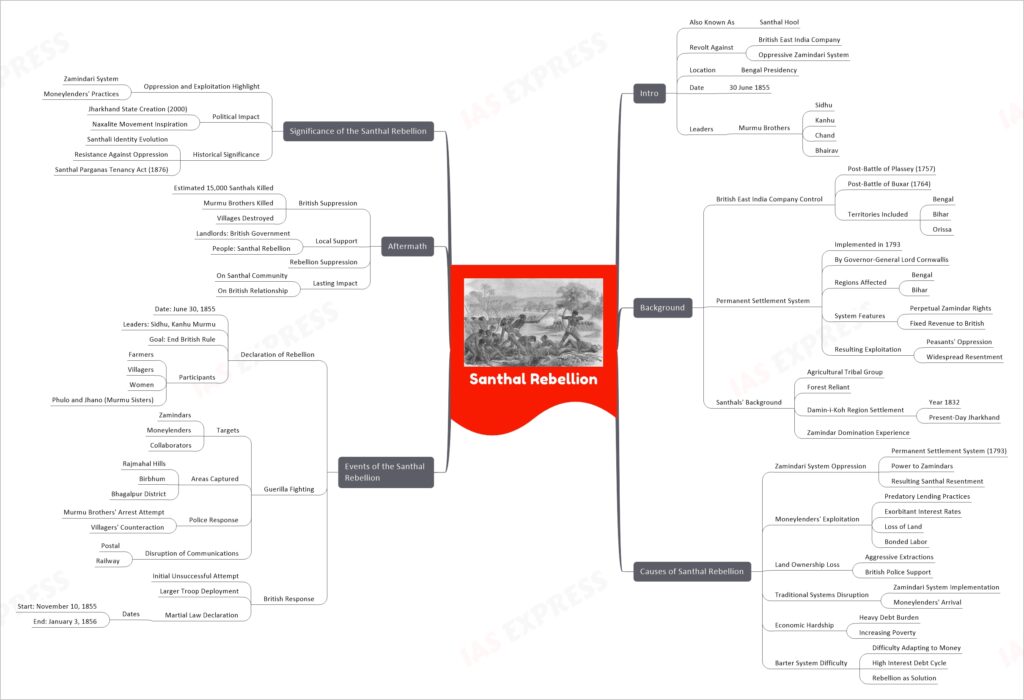Santhal Rebellion (1855-56) – Causes, Events, Significance
The Santhal Rebellion, also known as Santhal Hool, was a revolt by the Santhal tribal people against the British East India Company’s oppressive zamindari system in Bengal Presidency. The rebellion took place on 30 June 1855 and was led by four Murmu Brothers – Sidhu, Kanhu, Chand, and Bhairav.
Background
- The British East India Company gained control over Indian territories such as Bengal, Bihar, and Orissa after the Battle of Plassey (1757) and the Battle of Buxar (1764).
- In 1793, Governor-General Lord Cornwallis implemented the Permanent Settlement System in the Bengal and Bihar region.
- This system granted zamindars perpetual and hereditary rights over the land in exchange for paying a fixed revenue to the British government.
- However, this system led to the exploitation of peasants and caused widespread resentment among the local population.
- The Santhals were an agricultural tribal group who lived in forests and relied on them for their livelihood. In 1832, the East India Company demarcated the Damin-i-Koh region, now present-day Jharkhand, and invited Santhals to settle there.
- Many Santhals took up this offer and settled in the region, but soon found themselves dominated by zamindars, who were tax-collecting intermediaries employed by the East India Company and had a great influence over the economy.
Causes of Santhal Rebellion
- Oppression under the Zamindari System:
- The British East India Company implemented the Permanent Settlement System in 1793 which granted zamindars (tax-collecting intermediaries) perpetual and hereditary rights to land in exchange for a fixed revenue paid to the government.
- This system, however, gave zamindars significant power to exploit and oppress peasants, leading to widespread resentment among the Santhal community.
- Exploitation by Moneylenders:
- Many Santhals fell victim to predatory lending practices, where they were charged exorbitant interest rates on loans.
- When they were unable to repay these loans, they often lost their land and were forced into bonded labor.
- Loss of Land Ownership:
- The zamindars and moneylenders, with the support of the British police, frequently dispossessed the Santhals of their land through aggressive extractions.
- This resulted in a significant loss of land ownership for the Santhal community.
- Disruption of Traditional Systems:
- The implementation of the Zamindari system and the arrival of moneylenders led to the disruption of traditional systems and political structures that had been in place for generations among the Santhals.
- Economic Hardship:
- The Santhals were forced to rely on moneylenders, which led to a heavy debt burden and increasing poverty among the community.
- This economic hardship contributed to the decision of many Santhals to revolt against the British and the zamindars.
- Barter System:
- The Santhals traditionally used a barter system and had difficulty adapting to the use of money.
- This made it difficult for them to pay the zamindars, and they often had to borrow from moneylenders at high interest rates, trapping them in a cycle of debt.
- The only way out of this situation was to resist British policies and reclaim their traditional way of life.
Events of the Santhal Rebellion:
- On June 30th, 1855:
- Two Santhal leaders, Sidhu and Kanhu Murmu, rallied over 10,000 of their fellow Santhals and declared rebellion against the British East India Company.
- Their goal was to end British rule and reclaim their land.
- They formed their own troops, comprising of farmers, villagers, and even women.
- The sisters of the Murmu brothers, Phulo and Jhano, also actively participated in the rebellion.
- Guerilla Fighting:
- Shortly after the declaration of rebellion, the Santhal took to guerilla tactics.
- They targeted zamindars, moneylenders, and their collaborators in villages across the region.
- They captured large areas of land, including the Rajmahal hills, Bhirbhum and Bhagalpur district.
- When the police attempted to arrest the Murmu brothers, the villagers killed them.
- The Santhal army also disrupted postal and railway communications.
- British Response:
- The British government recognized the rebellion as a significant threat and sent a small contingent to suppress it.
- They were initially unsuccessful, which further fueled the rebellion.
- As the situation spiraled out of control, the East India Company sent a larger number of troops.
- The British government employed all available means to put down the revolt, including declaring martial law on November 10, 1855, which lasted until January 3, 1856.
- Aftermath:
- The British troops killed an estimated 15,000 Santhal villagers, including Sidhu and Kanhu Murmu, and destroyed their villages.
- Landlords supported the government, while local people, including milkmen and blacksmiths, supported the Santhal rebellion.
- The rebellion was eventually suppressed, but it left a lasting impact on the Santhal community and their relationship with the British government.
Significance of the Santhal Rebellion
- Oppression and Exploitation:
- The Santhal Rebellion brought attention to the oppressive nature of the zamindari system imposed by the British East India Company on indigenous communities in the region.
- It also highlighted the exploitative practices of moneylenders, who took advantage of the indigenous people’s lack of understanding of currency and charged exorbitant interest rates on loans.
- Political Impact:
- The rebellion played an important role in the creation of the state of Jharkhand in 2000, which is home to a significant population of the Santhal people.
- It also served as an inspiration for the Naxalite movement, which aimed to address similar issues of land rights and exploitation faced by tribal communities in India.
- Historical Significance:
- The rebellion is considered a turning point in the evolution of the modern Santhali identity and resistance against oppression.
- It also led to the British government passing the Santhal Parganas Tenancy Act in 1876, which offered some protection for tribals against exploitation.
Overall, the rebellion remains a watershed moment in the evolution of the modern Santhali identity and resistance against oppression.


